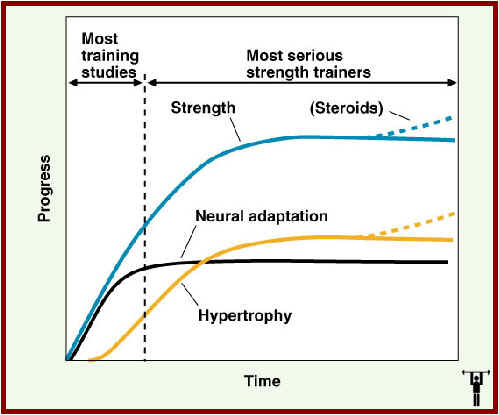Snowman
Level 6 Valued Member
I like this list, not so much as a guide for progression, but more as a guide for selection. If I want a comprehensive training program, (i.e. GPP), I just have to make sure whatever I'm doing covers all the bases.
- Increase capilary density
- Increase connective tissue density
- Increase motor unit recruitment
- Increase heart stroke volume
- Increase heart stroke pressure
- Reduce lactate buildup
- Increase lactate throughput
- Increase lactate resistance
- Increase mitochondrial density
- Increase muscle cell volume
I could start with low-intensity jogging. That takes care of 1, 2 (but only in the feet and lower legs), 4, 6, and 9.
I'm left with 2 (for the rest of the body), 3, 5, 7, 8, and 10 (although #10 may not be desired).
If #10 isn't desired, then high intensity/low volume resistance training will take care of 2, 3, and 5, and doing a few appropriately programmed HIIT/HIRT sessions would take care of 7 and 8.
If I do want hypertrophy, I could adjust the resistance training to increase volume, increase set duration, and decrease intensity. This would give me 2, 3 (to a lesser degree), 5 (to a greater degree), 7, 8, and 10.
If I wanted to start with A+A, that would cover 1 (not as well as LED work), 2, 3 4, 5 (not very much, though), 6, 9 (also not as well as LED work), and possibly 10 (depending on total training volume).
That leaves me with 7 and 8 that aren't really covered much at all, and 1, 5, and 9 that are perhaps being under-stimulated. Appropriately programed HIIT/HIRT sessions would take care of 7 and 8, as well as hitting 5 and 10 from another angle. Some LED work would bring up 1 and 9, if I wanted that.
If I start with HIIT as my base, I could potentially get some adaptation in every category (depending on what kind of HIIT I used), but I would have to use supplemental programs if I really wanted to develop specific traits effectively. For instance, HIIT+LED, HIIT+PTTP, etc.
I guess I'm saying that you could use this as a checklist to make sure that, whatever your combination of training methodologies, you're still hitting all the adaptations that you want to. You can also see where your training stimuli are overlapping, and make sure that it's in a way that is useful.
That still doesn't do much to answer your question about the continuum, though, but I'm not sure it needs to. You can develop different combinations of traits with different programs, so doesn't it all come down to goals?

